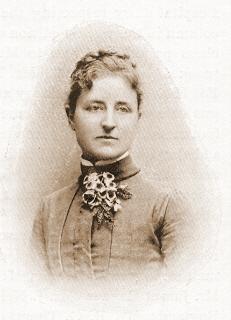
Edward Winter
The present article comprises three sections. First comes our ‘Diamond Jubilee’ account of chess activity in 1924, as contributed to the Chess Café in 1999. Section Two draws together subsequent C.N. items about the main event of the year, the New York tournament. Finally, Section Three offers a miscellany of other C.N. items concerning chess in 1924.
The great New York tournament was, of course, the event of the year, but what else happened in the chess world in 1924?
In a sense the answer is: surprisingly little. For Lasker, Capablanca and Alekhine, New York, 1924 was their sole formal appearance. Indeed, it was Capablanca’s only serious chess between August 1922 and November 1925. The Immortal Trio did, however, offer a number of simultaneous exhibitions. Here too Capablanca was the least prolific, giving just a handful, in the United States. Alekhine had preceded the New York tournament with an extensive tour of the US, also venturing into Canada, and Lasker’s 1924 displays were held in the Soviet Union, the United States, Yugoslavia, Czechoslovakia and Holland. Alekhine’s uncustomary inactivity – or, better say, quiescence – throughout the rest of 1924 is largely explained by a commitment to annotating all the games from the New York tournament. His book was published in German, English and Russian editions in 1925, and a Spanish version came out just after the Second World War. Rarely indeed has a tournament book appeared in so many languages.
The year had begun – as years still do – with the Christmas/New Year Congress at Hastings, an event won by a relative newcomer, the 22-year-old Max Euwe, with a score of +7 –1 =1, half a point ahead of a relative oldgoer, Géza Maróczy. It was Maróczy who scored the draw, and Euwe’s loss was at the hands of the Belgian Edgard Colle. On page 23 of Fifty-One Brilliant Chess Masterpieces, a Colle anthology published in 1950, Reinfeld wrote, ‘With this game the fiery elegance of Colle’s attacking play became known to the chess world’. Although it was not a particularly strong line-up at Hastings, Mieses, then 59, came two places from the bottom.
On 31 January Curt von Bardeleben, desperately impoverished, committed suicide by throwing himself out of the second-floor window of his residence in Berlin. Nowadays he is seldom mentioned except for his loss to Steinitz at Hastings, 1895, a game which Napier nominated as the finest ever played, and it is all but forgotten that in the same event von Bardeleben defeated the then world champion, Lasker. His many brief matches included wins and draws against masters of the standing of Blackburne, Teichmann, Spielmann and Leonhardt, but today it is almost as if they had never been played.
The day after von Bardeleben’s demise came the death of the ‘Queen of Chess’, Mrs W.J. Baird of England. Her obituary on page 125 of the March 1924 BCM estimated that she had composed over 2,000 problems, in addition to being ‘a valiant opponent over the board’ and an accomplished archer.

Mrs W.J. Baird
The Meran(o) tournament (4-22 February – the tournament immortalized by the Meran Variation) was won by Ernst Grünfeld, well ahead of Spielmann and Rubinstein. The ageing Tarrasch could do no better than finish tenth out of 14 players, but he captured the brilliancy prize for his defeat of Colle. Grünfeld is another master whose accomplishments have yet to be given their full due. The first phase of his career (1911-20) was well covered by Michael Ehn in a monograph from the Wiener Schachverlag in 1993, but no sequel has yet been published, and to many players nowadays Grünfeld is just an opening and not a human being.
By 1924 hypermodernism was close to its peak, with the openings propaganda war in full swing. Tartakower’s Die hypermoderne Schachpartie had started to appear the previous year, and the January 1924 Wiener Schachzeitung (pages 5-12) offered the rare spectacle of two leading theoreticians, Grünfeld and Tartakower, debating its analysis. Grünfeld himself wrote a book in 1924, Die Damenbauereröffnung und das Damengambit, but it would seem to have had little impact. (Confusingly, another 1924 book was Das Damengambit und Damenbauerspiel by K. Emmrich. Its impact, if any, is even less evident.) After 1 d4 d5 Grünfeld’s practice at this time was to give an exclamation mark to 2 c4, claiming (Deutsche Schachzeitung, September 1924, page 209) that ‘2 Nf3 Nf6 3 c4! c5! 4 cxd5’ was weaker for White, and, in fact, gave Black equality. At all levels of the chess world it was proving a struggle to come to terms with the newfangled openings. The game Torre v Jennings, New York, 1924 began 1 d4 Nf6 2 Nf3 g6 3 Nc3 b6 4 e4 Bb7 5 Bd3 Bg7, prompting C.S. Howell to remark (American Chess Bulletin, December 1924, page 217): ‘Chess rules need revision, indeed, if Black must resort to the double “fianshutyourpiecesin” defense.’
Not that all theoreticians were solely concerned with openings theory. The March Wiener Schachzeitung (pages 77-78) reported that Réti had profited from a visit to Saragossa to undertake a little detective work, investigating the well-publicized claim that José Juncosa y Molina had set a world record by playing 32 blindfold games simultaneously and winning 29 of them. In the Berliner Börsen-Courier Réti filed his report; Juncosa had actually played five games. The other 27 opponents had signed up but not turned up.
After the New York tournament Réti went to South America and later in the year, playing hors concours, won the third Argentine National Tournament in Buenos Aires, finishing no fewer than four and a half points ahead of Roberto Grau. The ebullient Boris Kostić toured Australia and South Africa.
In early April Euwe won a match in Zutphen (Holland) against Colle (+5 –3 =0) and later the same month returned to Britain to win the Weston-super-Mare tournament, in front of Sir George Thomas and Znosko-Borovsky. Although it was a ten-man all-play-all event, there were three days when two rounds were played, thereby enabling the contest to be completed within a week. Euwe was also becoming a prolific writer, mainly in Tijdschrift van den Nederlandschen Schaakbond, where an increasing number of annotated games ended with ‘M.E.’.
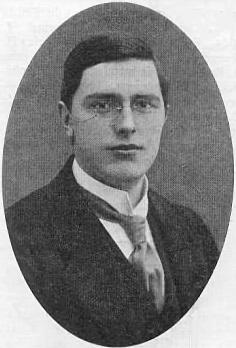
Max Euwe
Meanwhile the June 1924 BCM went badly astray by reporting the death of the French problemist Gustave Lazard, its claim being based on a simple misunderstanding. In fact, Lazard (perhaps one should say Lazarus) lived on until 30 November 1948, as recorded by L’Echiquier de Paris, January-February 1949, page 6. His younger, more famous brother Frédéric predeceased him by 12 days.
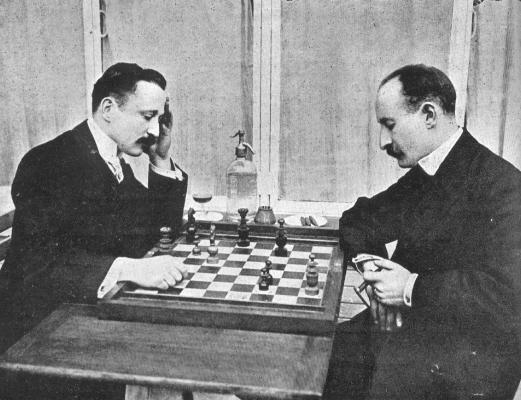
Frédéric (left) and Gustave Lazard
The name of the 18-year-old Vera Menchik started to be seen more often in chess periodicals, and page 273 of the July 1924 BCM commented that her style was ‘a demonstration both of her own talent and of the benefit she has derived from Maróczy’s coaching’. Just three years later she won the women’s world championship, a title she retained until her death in 1944.
Mieses and Teichmann shared first prize in a small Leipzig tournament (27 June-1 July), each winning all his games apart from the draw in their individual encounter. Another event that summer was the Paris Olympic Tournament in July. Participants in the complex set-up included Colle, Duchamp, Euwe, Mattison, Rey Ardid and Rueb, and the top honours, together with the not altogether prestigious title of ‘Amateur World Champion’, went to Mattison. The whole tournament was despatched in just one week. Bringing up the rear in national terms were Russia and Yugoslavia, but this was because they were represented by only one player and two players respectively. A book on the tourney, containing 258 games, was published by M.A. Lachaga in Argentina, but not until nearly 50 years later.
Paris, 1924 also marked the foundation of the Fédération Internationale des Echecs, with the appointment of the above-mentioned Alexander Rueb of The Hague as its President. Initially there were 15 signatories to FIDE: Argentina, Belgium, Canada, Czechoslovakia, Finland, France, Great Britain, Holland, Hungary, Italy, Poland, Romania, Spain, Switzerland and Yugoslavia. The Lachaga book reprinted the document which established the organization, whose statutory aims were expressed as follows:
‘La Fédération Internationale des Echecs aura pour but le développement de l’art des échecs, comme jeu universel, de propager l’idée d’entente entre les fédérations, de favoriser toute démonstration internationale relative au jeu d’échecs.’
With the ink scarcely dry on these noble generalities, the politicking began. Deutsches Wochenschach wanted to know what would be done about countries with a strong racial minority which had formed an independent chess association, such as the German Chess Association in Czechoslovakia. The ‘Olympic Tournament’ itself had provoked controversy, on the grounds that it could not legitimately decide the amateur championship of the world while nations such as Germany and ‘German Austria’ were barred.
Also in the summer of 1924 the British Championship was held in Southport. It was won by H.E. Atkins, who celebrated his 52nd birthday during the event. It was his eighth national title, though the first since 1911. (He was also to win once more, in 1925.) The ‘Major Open’ tournament played concurrently found Rubinstein outclassing a rather weak field, scoring 11 straight victories.
The Dutch championship in Amsterdam was won by Euwe, ahead of Jacques Davidson, and towards the end of the year the two played a match, which Euwe won +5 –1 =3. J.H. Morrison won the Canadian Championship in Hamilton with a score of +13 –0 =2, and page 176 of the September-October 1924 American Chess Bulletin recorded: ‘Play went full steam ahead, with two rounds a day and three on the Friday, in order to meet the requirements of those players whose time was limited.’ Around the same period the Hungarian Chess Federation Congress in Győr was won by Nagy ahead of Przepiórka and Asztalos. Later in the year Maróczy, who had finished only equal eighth, brought out the tournament book, with light notes in German. At the Nordic Chess Congress in August, Nimzowitsch outshone all rivals, scoring +9 –0 =1 to finish first ahead of P. Johner. It was Nimzowitsch’s only formal event of 1924, but he was writing extensively, and his first two books, Die Blockade and Mein System, were to be published the following year.
Detroit was the venue for the 25th Western Chess Association Tournament (23 August-2 September). The prodigy Reshevsky, his days as a touring Wunderkind behind him, came fifth, and it was the 18-year-old Carlos Torre who emerged victorious from the 17-man field, by a two-and-a-half point margin.
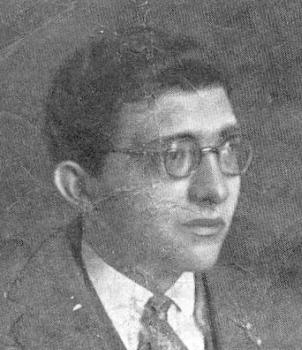
Carlos Torre
The July-August American Chess Bulletin (page 156) remarked that ‘Carlos Torre, the young Mexican expert, who for several years has made his home in New Orleans, where he outranked all others in interest in chess, recently came to New York and affiliated himself with the Marshall Chess Club. Like Capablanca, he has shown himself to be almost invincible in rapid transit play, although primarily he prefers slow, studious play.’ On pages 166-170 of the September-October issue of the same magazine, C.S. Howell presented some of Torre’s best games and offered a challenging comment on the Mexican:
‘He lacks technique and for the sake of his chess future, I hope that he will not hasten too much in cultivating it. Acquired naturally and as a result of the experience of play, technique is a valuable asset but the attempt to acquire it before one’s ability to combine has been fully developed has stopped permanently the improvement of a good many young players.’
The All-Russian tournament of 1924 (i.e. the third USSR Championship), played from 28 August to 15 September, was won by Bogoljubow, two and a half points clear of Romanovsky. Other well-known participants included Bogatyrchuk, Levenfish, I. Rabinovich and Dus-Chotimirsky. The Soviet Union was paying ever more attention to Western chess, and 1924 saw the publication of Russian translations of two Capablanca books, My Chess Career and Chess Fundamentals. The former had a striking silhouette of the Cuban on the front cover, and the editions doubtless helped pave the way for the extraordinary popularity that he was to enjoy during his stay in the Soviet Union the following year.
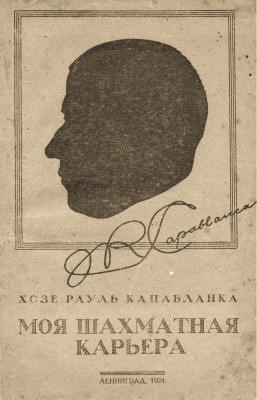
On 1 September J.H. Blackburne died at the age of 82, although most of the obituaries mysteriously gave his year of birth as 1842 instead of 1841. Inevitably many also spoke of the end of an era and the last link with a bygone age, phrases which were to be wheeled out again the following year when Amos Burn died and, once more, with the death of Gunsberg in 1930. Due emphasis was placed on the magnificence and duration of Blackburne’s career, and there were many anecdotes about his happy-go-lucky approach to simultaneous displays, counter-balanced by occasional references to his testiness. On page 402 of the October 1924 BCM, John Keeble reminisced:
‘Mr Blackburne held one peculiar view on chess. I showed him a problem in which en passant occurred. He at once said he thought that when an International Chess Federation is formed, one of their first acts will be to abolish PxP en passant from the game of chess, and I think he meant it, for in later years he adhered to that view.’
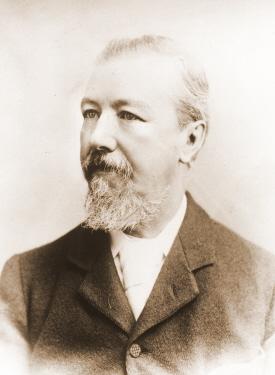
Joseph Henry Blackburne
Other notable deaths in 1924 included George E. Carpenter (a gifted problemist), Eugène Chatard (who has the distinction of joint billing with Alekhine in a variation of the French Defence), Harry Davidson (a strong player from Philadelphia), Václav Kautský (one of Czechoslovakia’s leading chess figures, dead at only 44) and Stepan Levitzky (immortalized by his loss to Marshall at Breslau, 1912).
It cannot be asserted that 1924 was a vintage year for chess literature. Alekhine’s book of the Hastings, 1922 tournament finally showed up, and the BCM (June 1924 issue, page 225) commented darkly, ‘the late appearance of the book is not, we believe, due at all to the editor and printer’. In his preface to the book W.H. Watts also referred to the delay, absolving himself of blame, and adding blandly that there seemed to have been ‘a misunderstanding between the parties concerned’. In a rare tribute from one leading master to another, Rudolf Spielmann produced a 178-page monograph in Swedish on Schlechter’s best games and problems. Another important work was Troitzky’s 500 Endspielstudien. On a lower literary rung stood Chess of To-day by Alfred Emery, about which the December BCM (page 485) remarked, ‘Despite the increased cost of printing and paper since 1914, we think that a cloth cover might have been provided for the half-crown.’ The magazine (June 1924 issue, page 226) had been more impressed by a book published earlier in the year, Chess Masterpieces by W.H. Watts, 50 annotated games and ‘the cheapest shillingsworth we have seen for many a long day’. The American Chess Bulletin (May-June 1924, page 131) also liked it, but revealed itself as a stickler for historical accuracy concerning the book’s illustrations: ‘it might be well to point out that Alekhine has since shaved off his moustache and that Bogoljubow has become a jolly “200-pound master” – a fact that the photographs in this book would hardly lead one to surmise.’
In a relatively quiet year for chess, periodicals had much space available for dross and trivia. A news item in the November issue of the Chess Amateur (page 34) read, in full: ‘The Bury and West Suffolk Chess Club is now starting its 57th season with a strong membership.’ The same month the BCM announced (page 447): ‘The Grimsby Chess Club has just entered on its jubilee season and has had an unbroken record of unostentatious success. There are nearly 60 members, one of whom once beat Capablanca in a simultaneous display.’ The same month F.P. Betts of London, Ontario had a letter published on page 204 of the American Chess Bulletin in which he denounced a book by Edward Lasker (unnamed, but presumably Chess and Checkers The Way to Mastership) for using the ‘extraordinary’ algebraic notation. ‘This mania for improving the established chess notation by freak innovations seems to entirely overlook the fact that there is an immense volume of chess literature centuries old in which the old and accepted notation is enshrined, the value of which would be greatly impaired if this novel jargon should become the vogue.’
One of the last tournaments of the year was a small double-round, four-man event in Berlin on 9-17 December, unexpectedly won by P. Johner of Switzerland ahead of Rubinstein, Teichmann and Mieses. (It was the final tournament of Teichmann’s career, and he died about six months later.) Then, as 1924 drew to a close, it was back to Hastings with, for once, abandonment of the single all-play-all format. Maróczy and Tartakower were to finish equal first, but that news, of course, belongs to 1925.
We conclude with some little-known games and positions gleaned from the two-volume Schachjahrbuch 1924 by Ludwig Bachmann. Apart from Mieses’ win, they all involve minor players and thus often illustrate the kind of chess produced by the rank and file 75 years ago.
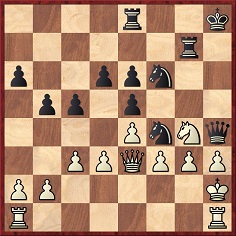
J. Dunkelblum-E. Sapira, Antwerp, 17 February 1924
In reply to 38 g3, Black now played 38…Rxg4 39 fxg4 Nxg4+ 40 Kg1 Nxh3+ 41 Rxh3 Qxh3 42 Qf3 Qh2+ 43 Kf1 Ne3+ 44 Qxe3 Rf8+ 45 Ke1 Qh1+ 46 Ke2 Qg2+ 47 Kd1 Rf1+ and White resigned.
As theoreticians were stressing the value of doubled rooks on the seventh rank, one player found success by doubling his knights there:
L. Schmitt – Grimm
Munich, 30 March 1924
Queen’s Gambit Declined
1 Nf3 c5 2 g3 d5 3 Bg2 Nf6 4 O-O Bf5 5 c4 e6 6 cxd5 exd5 7 d4 Nc6 8 Nc3 Be7 9 Bg5 O-O 10 dxc5 d4 11 Na4 h6 12 Bf4 d3 13 e3 Ne4 14 Ne5 Nb4 15 g4 Bh7 16 Qb3 Qa5 17 a3 Nc2 18 Rad1 Nd2
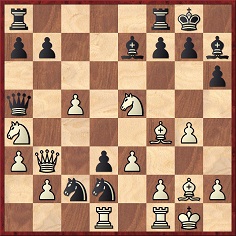
19 Rxd2 Qxd2 20 Nc4 Qe2 21 h3 d2 22 Nc3 Qd3 23 Ne5 Qd8 24 Bxb7 Bxc5 25 Bxa8 Qxa8 26 Nd7 Ne1 27 e4 Bxe4 28 Kh2 Bc2 29 Qd5 Qxd5 30 Nxd5 d1(Q) 31 White resigns.
A forgotten game by Mieses:
Jacques Mieses – O. Goertz
Leipzig, 30 June 1924
Sicilian Defence
1 e4 c5 2 Nc3 e6 3 Nge2 Nc6 4 g3 Nf6 5 Bg2 Be7 6 d4 cxd4 7 Nxd4 a6 8 O-O Qc7 9 Re1 h5 10 Bf4 Qb6 11 Be3 Ng4 12 Nf5 Nxe3 13 Nxe3 Qxb2
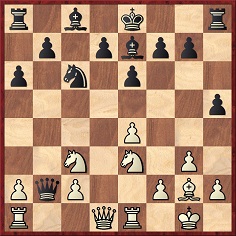
14 Ncd5 Bd8 15 Nc4 Qd4 16 Nd6+ Kf8 17 Qe2 Qc5 18 e5 exd5 19 Rad1 d4 20 Rd3 Be7 21 Rf3 Nxe5 22 Rxf7+ Kg8 23 Rxe7 Ng6 24 Qf3 Resigns.
A rapid transit game:
von Seefried – Künzler
Munich, 15 November 1924
Queen’s Gambit Declined
1 d4 d5 2 Nf3 c6 3 c4 Nf6 4 Nc3 Bf5 5 Bg5 Ne4 6 cxd5 cxd5 7 Qb3 Qa5 8 Qxd5 Qxd5 9 Nxd5 Na6 10 e3 e6 11 Bb5 mate.
There cannot be many games which end in such a quick mate after an exchange of queens. For some reason various databases incorrectly give 1927 as the date.
A position from Giersing v Kinch, Copenhagen, 1924:
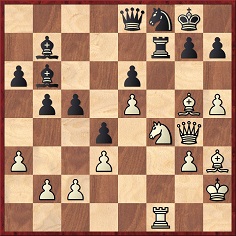
White won as follows: 30 Bf6 Kh8 31 Ng6+ hxg6 32 hxg6 Rc7 33 Be7 Qxg6 34 Rxf8+ Kh7 35 Rh8+ Kxh8 36 Qxg6 Rxe7 37 Bxe6 Bf3 38 g4 Resigns.
T. Steinebach – Radloff
Frankfurt, 1924
Two Knights’ Defence
1 e4 e5 2 Nf3 Nc6 3 Bc4 Nf6 4 d4 d5 5 exd5 Nxd5 6 dxe5 Be6 7 O-O Be7 8 Nbd2 Na5 9 Bd3 Nb4 10 Bb5+ c6 11 Be2 b5 12 a3 Nd5 13 c4 Nc7 14 cxb5 cxb5 15 b4 Nc6 16 Bb2 a6 17 Rc1 Bd5 18 Qc2 Ne6 19 Ne4 Rc8 20 Ng3 Qb6 21 Rfd1 Nf4
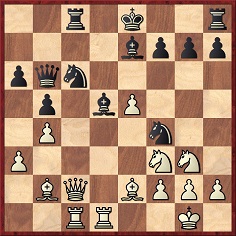
22 Rxd5 Nxd5 23 Qe4 Rd8 24 Nf5 O-O 25 Bd3 g6 26 e6 Bf6 27 Rxc6 Qxc6 28 Nh6+ Kg7 29 Bxf6+ Kxf6 30 e7 Qe6 31 exd8(Q)+ Rxd8 32 Qh4+ Kg7 33 Nf5+ gxf5 34 Qg5+ Qg6 35 Qxd8 and Black resigned a few moves later.
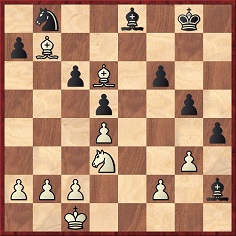
Loerbroks-Clauss, Inter-city match (Stuttgart v Pforzheim), 1924
White has just played 24 Bd6, and play went 24…Bd7 25 Bxb8 h3 26 Nc5 Bg4 27 Bxc6 Bf3 28 Nd3 g4 29 Ne1 Be4 30 f3 gxf3 31 Nd3 Bg1 32 g4 f2 33 Nxf2 Bxf2 34 Bh2 Bxd4, and White resigned since 35…Be5 will follow.
Finally, a rare line in the Marshall Counter-Gambit:
Sinischa – Poliaxoff (Poljakhov?)
Belgrade, 1924
Ruy López
1 e4 e5 2 Nf3 Nc6 3 Bb5 a6 4 Ba4 Nf6 5 O-O Be7 6 Re1 b5 7 Bb3 O-O 8 c3 d5 9 exd5 Nxd5 10 d3 Bg4 11 Nbd2 Nf4 12 Bc2 Nxd3 13 Bxd3 Qxd3 14 h3 Bh5 15 g4 Bg6 16 Nxe5 Nxe5 17 Rxe5 Qd7 18 Qe2 Bd6 19 Re3 Bc5 20 Rg3 Rfe8 21 Qf3 Re1+ 22 Kg2 Rae8 23 b4
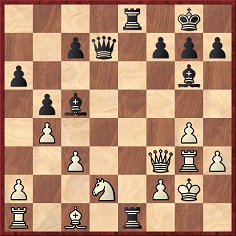
23…Bxf2 24 Kxf2 Qe6 25 Kg2 Qb6 26 Kh2 R8e2+ 27 Rg2 Qg1+ 28 Kg3 Rxg2+ 29 Qxg2 Re3+ 30 Nf3 Rxf3+ 31 Kxf3 Be4+ 32 Resigns.
From a letter contributed by Leonard B. Meyer to Chess Review, June 1949, page 161, regarding the conclusion of the New York, 1924 tournament:
‘… local chess-players were divided into Capablanca, Marshall and Réti camps, and I was in the center as a member of the brilliancy prize committee. I was strongly in favor of giving the first prize to Réti for his game against Bogoljubow. The other judges were Hermann Helms and Norbert Lederer, and it was common knowledge that originally the committeemen did not see eye to eye. However, on the night before the dinner at which the awards were to be made, the committee finally unanimously selected this game for first prize.
The next day a bomb burst. There had been a leak, and Herbert R. Limburg, president of the congress, was in a dither. He had received a letter from John Barry, objecting to the committee’s decision. The letter also included a vitriolic attack against me. It began about as follows: “It has come to my knowledge that one Meyer, who is either a knave or a moron, has decided to give the brilliancy prize to Réti”. The balance of the letter, besides discussing patriotism, included a system for deciding prizes, with points for various types of sacrifices, all of which added up to first prize for Marshall for his game with Bogoljubow.
At a hastily called meeting of the tournament committee, the decision of the brilliancy prize committee was upheld. To further sustain the verdict, I quote the following from Dr Alekhine’s annotations to the Réti-Bogoljubow game in the tournament book: “Rightfully, this game was awarded the first brilliancy prize.”
In 1930, I met Dr Tartakower in Paris. He told me that, in his opinion, when all other details of the tournament are forgotten, the Réti-Bogoljubow game will be remembered as one of the six greatest games ever played.
… It is like judging any other work of art: the experts are bound to disagree.
Just for the record, in later years, Barry apologized, and we buried the hatchet.’
(2538)
Near-identical twins are always of interest. C.N. 3351 presented a photograph (New York, 1924) from Homenaje a José Raúl Capablanca (Havana, 1943):
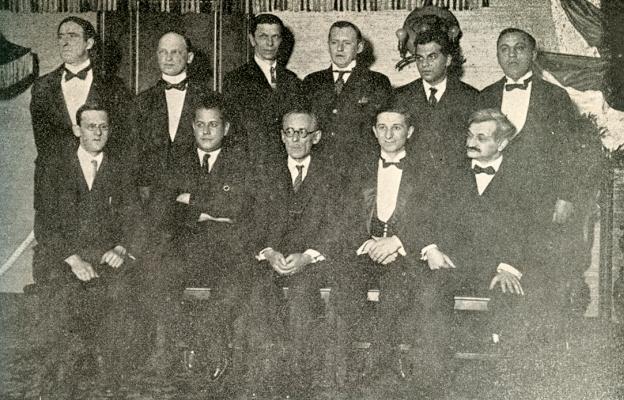
Our comment was: ‘Any reader who thinks that we are merely reproducing a famous shot is invited to look more closely.’
John Hilbert (Amherst, NY, USA) enquires about a matter discussed on pages 195-197 of our book on Capablanca: Lasker’s allegation that owing to a defective clock he lost 20 minutes during his defeat at the hands of the Cuban at New York on 5 April 1924. We quoted from De Telegraaf of 3 January 1927 Lasker’s strong attack on the tournament organizers in explanation of his refusal to participate in New York, 1927.
Our correspondent asks whether the 1924 clock dispute was public knowledge before Lasker’s article appeared nearly three years later.
(5080)
Luca D’Ambrosio (Bolzano, Italy) cites the following from page 74 of Deutsches Wochenschach, 30 April 1924:
‘Auffällig ist eine Mitteilung, die Dr. A. Seitz, der als Zuschauer dem Turnier beigewohnt hat, über die Partie Capablanca-Dr. Lasker macht. Danach wäre die Niederlage L’s die Folge eines Uhrendefekts. L sei infolge dieses Defekts, der zur Folge hatte, daß im kritischen Augenblick beide Uhren gingen, in Zeitnot geraten u. habe das Remis übersehen.’ [Our English translation: ‘A noteworthy report comes from Dr A. Seitz, who attended the tournament as a spectator, regarding the Capablanca-Dr Lasker game. It states that L.’s defeat was the result of a defective clock; owing to that fault, which caused both clocks to be running at the critical moment, Lasker fell into Zeitnot and overlooked the draw.’]
More generally, our correspondent refers to a sentence written by Seitz on page 146 of the May 1924 Wiener Schachzeitung:
‘Dem Turniersekretär konnte man nicht das Lob allzu großer Unparteilichkeit geben.’ [‘The tournament secretary could not be praised for excessive impartiality.’]
Finally, Mr D’Ambrosio quotes a passage from the report about New York, 1924 on page 3 of volume one of Schachjahrbuch 1924 by L. Bachmann (Ansbach, 1925):
‘Über ihre Aufnahme und ihren Aufenthalt haben sich die Turnierteilnehmer sehr günstig ausgedrückt. Selbstverständlich gab es die regelmässigen Klagen über gewisse Rücksichtslosigkeiten einzelner Meister, wie gewöhnlich so auch hier, auch fehlten nicht Beschwerden wegen Parteilichkeit des Turnierleiters von deutscher Seite.’ [‘The participants in the tournament expressed great satisfaction with their welcome and stay. Of course, there were the regular grievances about certain inconsiderate behaviour by individual masters, as is usual and as occurred here too, and there was no lack of complaints of favouritism by the tournament director, from the German side.’]
(5088)
Luca D’Ambrosio submits a further report on the dispute regarding the game Capablanca v Emanuel Lasker, New York, 1924 (from Deutsches Wochenschach, 15 June 1924, page 110):
Our translation:
‘The apparent clock defect in the Capablanca-Lasker game. Dr A. Seitz stated in his tournament reports, among personal attacks on the New York tournament director, N.L. Lederer, that Lasker’s defeat against Capablanca was due to a clock defect, as a result of which at the critical moment both clocks were running and L., who was in Zeitnot, overlooked the draw. Ignoring the personal attacks, we briefly mentioned this information on page 74 on the assumption that an explanation would not be lacking. In a communication Mr Lederer has now drawn to our attention the fact that Dr Seitz did not have access to the playing tables and therefore knew of the matter only by hearsay. “I noticed”, observes Mr Lederer in this respect, “that during the game Dr L. did not press the ‘off’ lever on his clock far enough and that both clocks were running. When play was broken off at six o’clock, we noted precisely the time difference, which was around eight minutes. It should be remarked here that Dr L. was not in Zeitnot at any time. On the contrary, before the end of play C. was in considerable Zeitnot and twice after the piece sacrifice did not make the best moves (Qf3 instead of Qe2 and Nxd6 instead of g4 [sic]). When play resumed at eight o’clock both players were, of course, out of Zeitnot, and the move which, according to Dr L.’s analysis, offered Black the prospect of a draw (Bd5 instead of Qe6) took place long after play had been interrupted ... Dr L. has, of course, never made a remark which could be interpreted as meaning that he lost the game for any reasons other than those having to do with chess, and he spoke about his opponent’s play with the greatest respect; he merely remarked that Qe6 was the losing move and that Bd5 would probably have given him a draw, and analysis will surely bring a final verdict on this.” Mr Lederer goes on to express his regret over the derisive and denigrating comments made by Dr Seitz about the committee and the tournament management, which are as unjustified as they are untrue. He says that this could cause the men whom we have to thank for the organization of the tournament not to repeat their efforts, undertaken purely in the interests of chess, if the result of their work is mean-spirited attacks by people who have enjoyed the hospitality of the Manhattan Chess Club and the Hotel Alamac. In the end, Dr Seitz was requested no longer to enter the premises of the Manhattan Chess Club.’
When the Lasker affair blew up in the United States in January 1927, Lederer wrote as follows regarding the clock incident on page 71 of the March 1927 American Chess Bulletin:
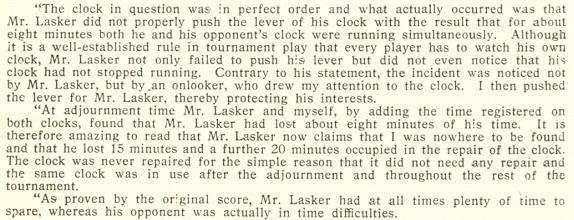
The rules for New York, 1924 were given on pages 27-28 of the February 1924 American Chess Bulletin. The time-limit was 30 moves in the first two hours and 15 moves an hour thereafter. The playing hours stipulated there (13.30-17.30 and 19.30-23.30) were subsequently amended to 14.00-18.00 and 20.00-00.00 (American Chess Bulletin, March 1924, page 49). For Capablanca’s score-sheet of his victory over Lasker see page 80 of A Picture History of Chess by Fred Wilson (New York, 1981).
(5098)
Emanuel Lasker’s absence from New York, 1927 was due to a bitter dispute with the organizers of New York, 1924, and he issued a lengthy statement on the affair at the end of 1926. Much confusion and additional controversy arose because the text was published – in German, Dutch, Spanish and English – with many variants and discrepancies. Richard Forster (Winterthur, Switzerland) has sifted through all available versions of the statement in a special article presented here: Lasker Speaks Out (1926).
(11704)
Alekhine and Réti had opposite views on the worth of Capablanca’s sixth move in his game (as White) against Yates at New York, 1924 (1 d4 Nf6 2 Nf3 g6 3 Nc3 d5 4 Bf4 Bg7 5 e3 O-O 6 h3). Alekhine, in the tournament book, said it was ‘not exactly necessary ... after the text-move, Black obtains some counter-play, the defense of which will demand all of the world champion’s care’. Réti, however, calls 6 h3 ‘a move of genius’ (Homenaje a Capablanca, pages 185-186) For him it was ‘the most profound move of the entire game’. He explains its idea as follows (our résumé): if Black is to make the most of the king’s bishop he will need to play, eventually, either ...e5 or ...c5. Capablanca’s plan is to prevent the former, so as to force the latter. This will transfer the battle to the queen’s side, where White will have every chance of securing an advantage, owing to the absence on that flank of Black’s dark-squared bishop. Capablanca, in view of the position of his own bishop in the centre of the board, prevents the centre from becoming the battlefield by 6 h3. He does not allow Black to play 6...Bg4, followed by ...Nbd7 and ...e5.
(916)
C.N. 547 mentioned that in the New York, 1924 tournament book Alekhine remarked that Capablanca played the long endgame against Yates ‘with his usual precision’. This was at variance with his criticism of the Cuban’s endgame skill elsewhere. Our item referred to page 27 of the January 1980 BCM.
In C.N. 2117 Richard Forster (Zurich) referred to the position which arose after White’s 25th move in Réti v Marshall, New York, 1924 (see pages 165-166 of the English-language tournament book, published in 1925):
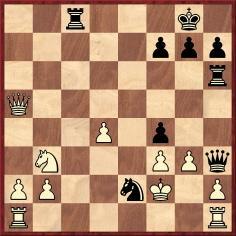
Play went 25...Nxg3 26 Rhg1, and Alekhine wrote: ‘Or 26 hxg3 Qxg3+ 27 Ke2 Qg2+ 28 Kd3 Rxh1 29 Rxh1 Qxf3+, to be followed by 30...Qxh1, with an easy win.’ Instead, there is 28...Qc2 mate.
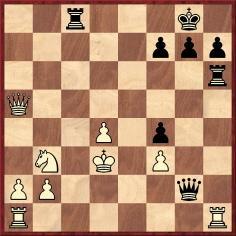
Analysis by Alekhine (position after 28 Kd3)
On page 33 of his 1929 book Schachmethodik Tartakower also ignored the mate, as did Soltis on page 270 of Frank Marshall, United States Chess Champion (Jefferson, 1994).
C.N. 2131 remarked that in the original 1925 edition of Alekhine’s tournament book W.H. Watts gave a nine-page errata supplement which mentioned (on page vi) 28...Qc2 mate, and when discussing the matter further on pages 283-284 of Kings, Commoners and Knaves we drew attention to some complications. Here is the complete game-score as it appeared in the tournament book (English and German editions):
Richard Réti – Frank James Marshall
New York, 6 April 1924
Queen’s Gambit Declined
1 Nf3 Nf6 2 c4 d5 3 cxd5 Nxd5 4 d4 Bf5 5 Nc3 e6 6 Qb3 Nc6 7 e4 Nxc3 8 exf5 Nd5 9 Bb5 Bb4+ 10 Bd2 Bxd2+ 11 Nxd2 exf5 12 Bxc6+ bxc6 13 O-O O-O 14 Qa4 Rb8 15 Nb3 Rb6 16 Qxa7 Qg5 17 Qa5 c5
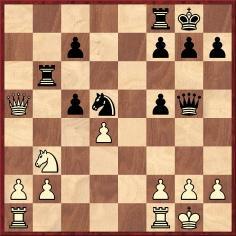
18 Qxc5 Nf4 19 g3 Rh6 20 Qxc7 Ne2+ 21 Kg2 Qg4 22 Rh1 f4 23 f3 Qh3+ 24 Kf2 Rc8 25 Qa5 Nxg3 26 Rhg1 Qxh2+ 27 Rg2 Qh4 28 Rc1 Re8 29 Qb5 Ne4+ 30 Kf1 Qh1+ 31 White resigns.
However, we observed, when Réti annotated the game on pages 259-260 of the September 1924 Wiener Schachzeitung he gave White’s 18th move as 18 dxc5. If that were correct, Alekhine would have missed no mate later in the game. Hanon Russell (Milford, CT, USA), who possessed the original score-sheets of both Réti and Marshall, informed us that they respectively gave White’s 18th move as ‘Dxc5’ and ‘QxP’. A later transcription error in the German notation would have been easily made (i.e. ‘Dxc5’ becoming ‘dxc5’).
On page 126 of Das New Yorker Schachturnier 1927 (Berlin, 1928) Alekhine wrote regarding the communication of game-scores by telegraph:
‘But in general more accurate wire information for the foreign press should be provided during American tournaments. In 1924, for example, a similar error resulted in a wholly incorrect judgment of Marshall’s win against Réti.’
Here, a further point in this complex affair may be added. In 1924 Alekhine also annotated the game in Le Pion (Montreal); see pages 116-117 of the May 1924 issue of La Stratégie. He gave White’s 18th move as Qxc5, and at move 26 merely wrote, ‘If 26 hxg3 Qxg3+ 27 Ke2 Qg2+, winning easily’.
Das Grossmeister-Turnier New York 1924 was published in or around February 1925. It was reviewed on page 69 of the March 1925 Deutsche Schachzeitung and on pages 42-43 of the March 1925 American Chess Bulletin. The latter source also stated that publication of the English-language edition was imminent:
‘After many unforeseen and more or less vexatious delays, of which translation from the German was by no means the least, the home edition of the New York Tournament Book has at last reached the bindery ...’
(5414)
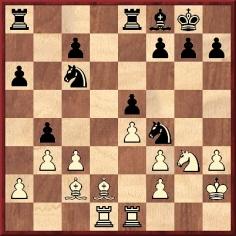
This position occurred after 21 Rfe1 in Tartakower v Réti, New York, 1924. Black played a rook to d8, but which rook?
The question has been put to us by Charles Sullivan (Davis, CA, USA), who comments that although various sources, including databases, give the next move as 21...Rad8, The Book of the New York International Chess Tournament 1924 by A. Alekhine (New York and London, 1925) put ‘KR-Q’ on page 191 and appended this note on the next page:
‘The queen’s rook stays at its own square in order eventually to make a demonstration on the queen’s side (P-QR4).’
We note, though, that page 267 of the German edition of Alekhine’s tournament book (Berlin and Leipzig, 1925) stated that the move played was 21...Rad8. Alekhine wrote that moving the king’s rook to d8 would have been an improvement:
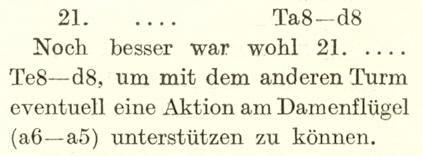
Tartakower annotated the game, which he lost, on pages 220-222 of the August 1924 Wiener Schachzeitung. 21...Rad8 was the move given, with an exclamation mark. It may therefore be strongly suspected that 21...Red8 in the English edition of the New York, 1924 book was wrong, possibly owing to a misunderstanding and/or translation error, but the matter has yet to be put beyond doubt.
Notwithstanding the quality of Alekhine’s annotations, the book was a lax production. C.N. 2131 (see page 283 of Kings, Commoners and Knaves) mentioned that W.H. Watts added a nine-page errata supplement (to the British edition, of which he was the publisher). The list sheds no light on the ‘Which rook?’ puzzle but is, of course, indispensable in connection with any English-language edition of Alekhine’s book.
(5954)

American Chess Bulletin, July-August 1925, page 123.
Most of the corrections in the nine-page list, referred to in C.N. 5954, concern notation, but below are some examples of substantive matters:
(5955)
Noting that the ‘21st Century Edition’ of Alekhine’s New York, 1924 tournament book (Milford, 2008) does not identify the translator or the language in which Alekhine wrote, Michel Therrien (Saint-Laurent, Quebec, Canada) remarks that it is not unusual for such information to be omitted when old chess books are reissued.
In the particular case of The Book of the New York International Chess Tournament 1924 (New York and London, 1925), however, we point out that no translator or language was specified in the original edition, although H. Ransom Bigelow was credited with translating Alekhine’s article ‘The Significance of the New York Tournament in the Light of the Theory of the Openings’ (pages 247-267). Readers were thus left to assume that all the annotations were translated by the book’s editor, Hermann Helms, who was mentioned on the title page:
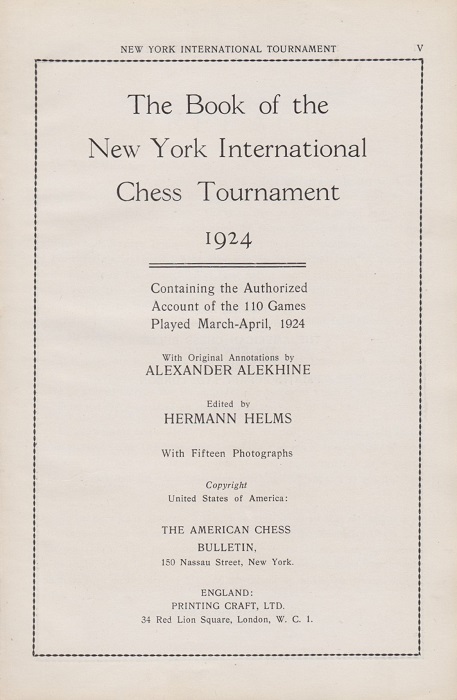
In the ‘21st Century Edition’ Helms was named as editor on the imprint page, whereas the writer of the two-page Foreword, A. Soltis, was mentioned on the front cover, the title page and the imprint page.
(9257)
Thomas Niessen (Aachen, Germany) raises two matters concerning New York, 1924 on the basis of information in the tournament book: a) the speed with which the event was organized and b) the pairing system used.
We offer some supplementary facts from the 1924 volume of the American Chess Bulletin, whose editor, Hermann Helms, was on the board of the tournament directors.
Page 1 of the January 1924 issue announced the proposed tournament:
‘First steps were taken at a meeting in New York on 18 January, having in view a possible gathering of the world’s leading experts as early as 17 March.
As we go to press, there is no absolute certainty as to its taking place, as planned. It is sufficient to say that a number of good men and true are bending all their energies to make it so. Should success crown their efforts, then the congress will be quite unique in the annals of the game, at least in so far as rapidity of action is concerned.
This much can be said. Thanks to good use of the cable, the readiness of several European masters to come over has been ascertained.’
And from page 2:
‘Although a total of nearly $10,000 will be required to defray the expenses, including the prizes, as well as the transportation of several European experts, close upon $4,000 was pledged as a starter [at the committee’s meeting on 18 January].
The members of the committee undertook to raise most of the balance through subscriptions within a fortnight, after which word was to be sent to Europe to the masters who are in readiness to come whenever the call is issued.’
Page 25 of the February 1924 Bulletin stated:
‘Since the announcement made in the January issue of the Bulletin, matters have progressed famously in connection with the New York International Chess Masters’ Tournament. It is now an assured fact. New York, therefore, will be the scene for a gathering of the world’s most famous masters, the like of which is not apt to be witnessed again in our generation.’
Page 4 of the tournament book reported:
‘With the hearty co-operation of Dr Arthur A. Bryant [the Treasurer] and Mr Helms, the preparations at this end were carried forward with the least possible delay, and on 8 March we were able to welcome the masters at the docks with the satisfying knowledge that everything was ship-shape, barring, perhaps, some of the masters. Several unforeseen incidents helped to maintain the interest and contribute a bit of anxiety, chiefly the illness of Capablanca from a severe attack of la grippe, which made his participation in the tournament somewhat doubtful up to the last minute.’
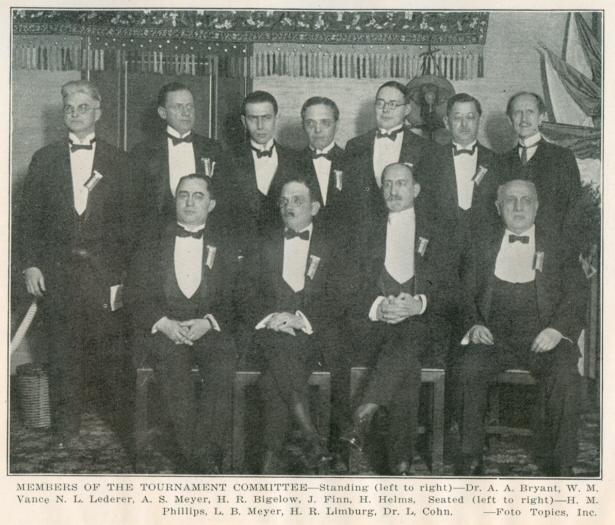
Source: page x of the tournament book.
The pairing system was set out in point 19 of the tournament rules (pages 27-28 of the February 1924 American Chess Bulletin):
‘The draw will be made according to the Berger system and the players will draw their own numbers before beginning of the tournament. The number of the round to be played each day will be decided by draw and announced 15 minutes before beginning of playing hours. The first half of the tournament must be completed before any of the rounds of the second half are drawn.
The draw for numbers took place on 11 March (American Chess Bulletin, March 1924, page 49), and the first round of play was on 16 March.
Mr Niessen asks whether other major tournaments have handled pairing in a similar way.
Steve Wrinn (Homer, NY, USA) quotes from the Hastings, 1895 tournament book edited by Horace F. Cheshire (London, 1896):
‘The order of play and pairing will be decided by the president drawing lots publicly immediately before the commencement of the Tournament. The future pairing will depend on this, but will not be known until the morning of each day. (Page 6.)
‘The president then made the draw of the names to match with the numbers with which the pairings had been arranged; ... this draw determined the first moves and the pairings of all the rounds, but not the order in which the rounds were to be played. The draw was then made for the round for the day, and the president explained that he, or in his absence the director in charge, would make this draw each day before play commenced.’ (Pages 10-11, in the section entitled ‘The Opening Day’.)
‘No-one knew, till the morning of each day, who would meet ...’ (Page 367, under ‘The Innovations’.)
(6631)
John Blackstone (Las Vegas, NV, USA) brings to our attention an article by an eminent writer on page 24 of the Brooklyn Daily Eagle, 28 March 1924:
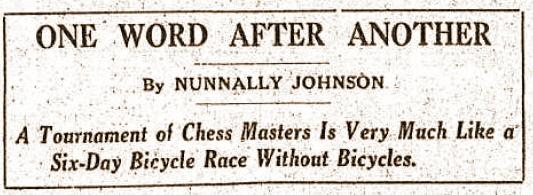
‘One Word after Another
By Nunnally Johnson
A Tournament of Chess Masters Is Very Much Like a Six-Day Bicycle Race Without Bicycles.Hand to hand, at such close grips that their fierce, hot breaths intermingle furiously, 11 giants are battling for world supremacy up at the Alamac Hotel in Manhattan.
They are chessplayers, the finest in the world, and probably the slowest, and their battle of the century is more sedately known as the International Chess Masters’ Tournament. Capablanca, Ed Lasker, F.J. Marshall, Bogoljubow – here are names to conjure with wherever the lure of chess has blown its hardy call. And if you would know what they look like, they look like chessplayers.
For thrill, for life and excitement, for – what is that charming French word which goes in here – verve? – yes, for verve, for all of those things, the only other athletic contest comparable to chess as the masters play it would be a six-day bicycle race. Perhaps, to be more accurate, it would be best to say, a 12-day bicycle race.
Chess fiends all over New York look forward to this grappling of the giants. Today, perhaps at the very moment you read this, they are crowding the long room of the second floor of the Alamac, being shushed by the attendants to preserve silence. It is quiet, so quiet, so very quiet indeed that the heavy rumble of furious thinking can be heard distinctly. If only it were a little rowdier one might fancy that it was a funeral.
The contestants, the men of all nations who have fought their way to the very top of the heap, sit, two-by-two, at tables along one wall. Two stop-clocks look down with them at the board. Cigarette butts, coffee cups, water glasses, the debris of all-night parties, are at their elbows. There is a steady buzz of “sh-sh-sh-sh” whenever the slightest sound rises.
Here in the middle is Capablanca, the Cuban wizard, whose fast under-hand move has revolutionized chess. Opposite him is Bogoljubow, the Ukrainian wizard, whose fast over-hand move has revolutionized chess. This between them is the star spectacle.
Bogoljubow is not a spectacular player. But he is known among chessplayers as the heady man, cool in the pinches and possessed of a wicked shift. He was drafted by the National League of Ukrainia after he had subdued the fast semi-pro Ukrainian All-Star Ukulele Players Chess Team during its spring training trip last year, setting them down, one, two, three. He made good from the start in big company and was soon bought by the Ukrainian Ugenots, the fastest chess combination in south-west Europe – or is it Asia?
They tell a very funny story about Bogoljubow when he came up to the Ugenots, a green Ukrainian country boy. He lost his first game through an odd and, as some say, dirty trick. In the beginning he lost the toss for goal and was forced to defend the Ukrainian east goal, known all over Europe as one of the sunniest fields in the world. And in addition to playing throughout the game with the fierce Ukrainian sun shining in his eyes, he erroneously played the game with his opponent’s men, the judges having deliberately failed to tell him which were his and which his opponent’s.
That Bogoljubow – or, as his friends familiarly call him, Bogoljubow – should now be in this contest and facing the great Capablanca is evidence of his sturdy constitution, unbreakable spirit and well-muscled back and shoulders. He was the kind of boy that was Bound to Make Good.
Moves do not occur to him as quickly as they do to Capablanca. The Cuban wizard sits down, thinks concisely for no more than half an hour, and presto! the trick is done. It is dazzling, his speed, and again and again yesterday the crowd was brought to its feet in outbursts of spontaneous sighing, which is the only form of cheering permitted.
Capablanca is the flashy player, the kind of man that has the crowd with him always, while good old Bogoljubow thinks and thinks and thinks. Time passes. More time passes. But Bogoljubow is thinking. He holds his head in his hands. He eyes them all, queens and those other little doodads on the board, individually and collectively. He writhes. He bites his nails. He twists in mental torment.
And Capablanca, the speed demon of the Hesperides, or thereabouts, paces nonchalantly up and down the runway, exercising, keeping his muscles fit, testing his chess expansion. He deigns only now and then to glance at his tortured opponent.
But Bogoljubow is thinking. The old Ukrainian noodle is hard at it. It was not for nothing that he was known in Ukrainia as the fiercest hand-to-hand thinker in European chess. His arm may give out some day, but still the old bean will be there, working steadily and efficiently.
And at last, as chance would have it, the solution came to him. He moved a gadget. With a smothered curse Capablanca sits down again suddenly, pauses a few hours, and then quickly, surely, promptly, he moves another gadget. It is all over so quickly that one scarcely has time to say Jack Robinson 12,000 times.
On and on it goes like that, from 2.30 [sic] to 6 p.m. each afternoon and again at night, beginning at 8 o’clock.
Down the line are other celebrities – Ed Lasker, from Chicago, using the famous Chicago sidewind before moving; Janowsky, from France, a cunning player with a deceptive straight-arm movement; old Dr Lasker of Germany, the veteran of 10,000 battles; the fierce Dr Tartakower from Austria, brooding madly over everything; the handsome Mr Alekhine of Russia, with a wing collar; Yates of England –
And among the spectators yesterday afternoon was “Ivory Luther” Hooks, the international indoor craps champion, which he won on the fields of Eton last year when he played under the colors of the Brooklyn Mah Jong and Clam Bake Association.
“I hope you do not ask me what I think of this game”, Mr Hooks said to a reporter, “but if you do I shall not tell you.”
This was all that could be got from him.’
(6681)
As shown below (C.N. 10926) the remark about bicycling was a recycling of what Jaffe wrote in the Baltimore Sun, 2 March 1924, page 4, part 1, section 2.
Olimpiu G. Urcan (Singapore) sends this article from the 16 March 1924 issue of the Brooklyn Daily Eagle (page A11):
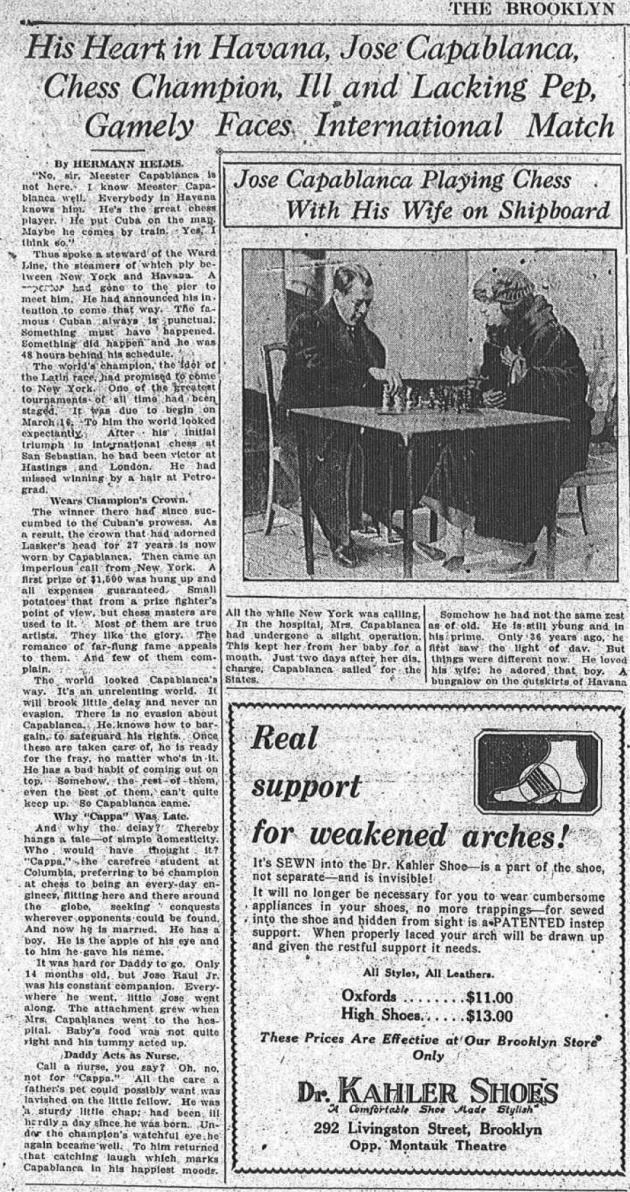
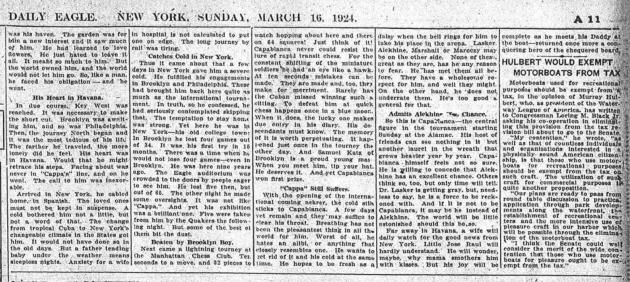
Larger version of the second part
(7097)
From page 105 of The Amazing Book of Chess by Gareth Williams (Godalming, 1999), in the section on Capablanca:
‘His losses became so rare that on one occasion the front page headline of the New York Times read “Capablanca Loses”.’
That sounds even more dramatic than what Harold C. Schonberg wrote on page 166 of Grandmasters of Chess (Philadelphia and New York, 1973):
‘At the New York, 1924 tournament he lost to Réti. So unexpected was that loss, so unbeatable had Capablanca been, that the New York Times commemorated Capablanca’s loss in a headline: CAPABLANCA LOSES/1ST GAME SINCE 1914. (The Times for once was inaccurate, for Capablanca had lost a game to Chajes in New York in 1916.)’
So, just how eye-catching was the newspaper’s front-page story on 23 March 1924, the day after the Cuban’s loss to Réti?
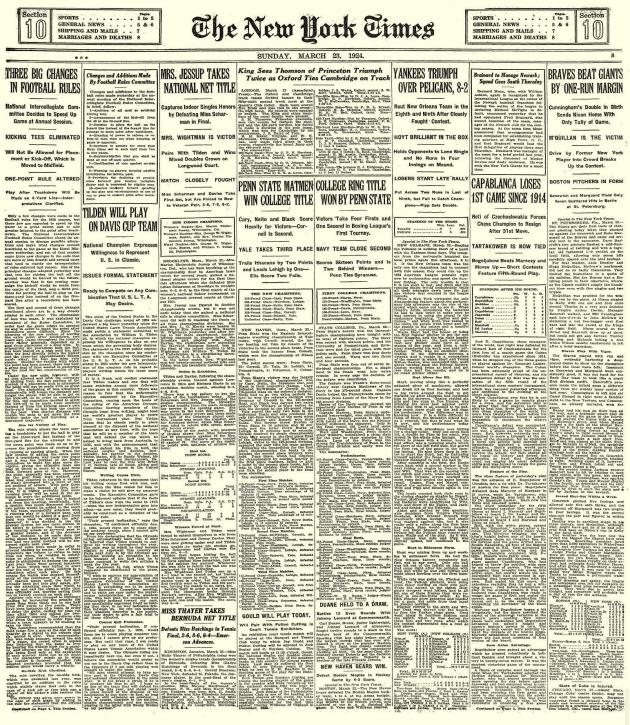
Contrary to the statement in the New York Times, the Cuban’s unbroken run (apart from the loss to Chajes in 1916) stretched back to his defeat by Tarrasch, and not Lasker, at St Petersburg, 1914.
(8205)
C.N. 8205 showed the report of Capablanca’s loss to Réti on the front page of the sports section of the New York Times, 23 March 1924.
There was no mention of the game on the newspaper’s very front page.
(8217)
Information is sought about Siegbert Tarrasch’s absence from New York, 1924 and, in particular, about a claim by Al Horowitz on an unnumbered page in Solitaire Chess (New York, 1962):
‘What really broke his spirit in the end was his non-admittance to the entry list of the great New York tournament of 1924. Lasker, who had been chosen to compete, had been wrangling for a higher retainer. The committee warned him that, if he didn’t accept the offer, Tarrasch would be his replacement. Lasker quickly came to terms.’
(8663)
Pete Klimek (Berkeley, CA, USA) notes that in an article by Hanon W. Russell about New York, 1924 at the Chess Café the first part has some references to Tarrasch.
(8666)
The links given by our correspondent in C.N. 8666 no longer work.
Wanted: the newspaper article referred to by Edward Lasker on page 159 of Chess for Fun & Chess for Blood (Philadelphia, 1942):
‘As Horace Bigelow, who covered the tournament for one of the New York papers, remarked at the time: “The modern school came, saw and succumbed.”’
From page 92 of Lasker’s The Adventure of Chess (New York, 1950):
‘... the amusing though erroneous comment of a chess columnist was: “The New School came, saw, and succumbed.”’
(8916)
From the Detroit Free Press (Rotogravure Supplement), 23 March 1924:
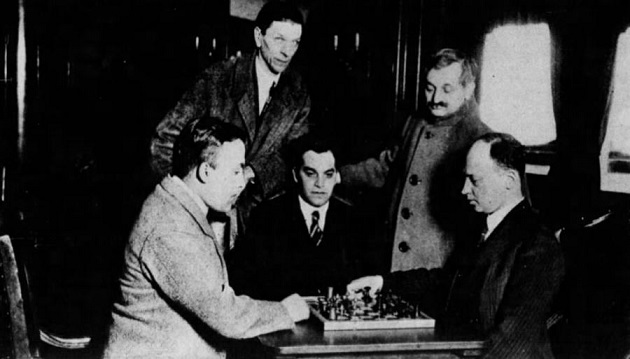
From left to right: Efim Bogoljubow, Géza Maróczy, Richard Réti, Emanuel Lasker, Savielly Tartakower
(10189)
A contribution from Olimpiu G. Urcan:
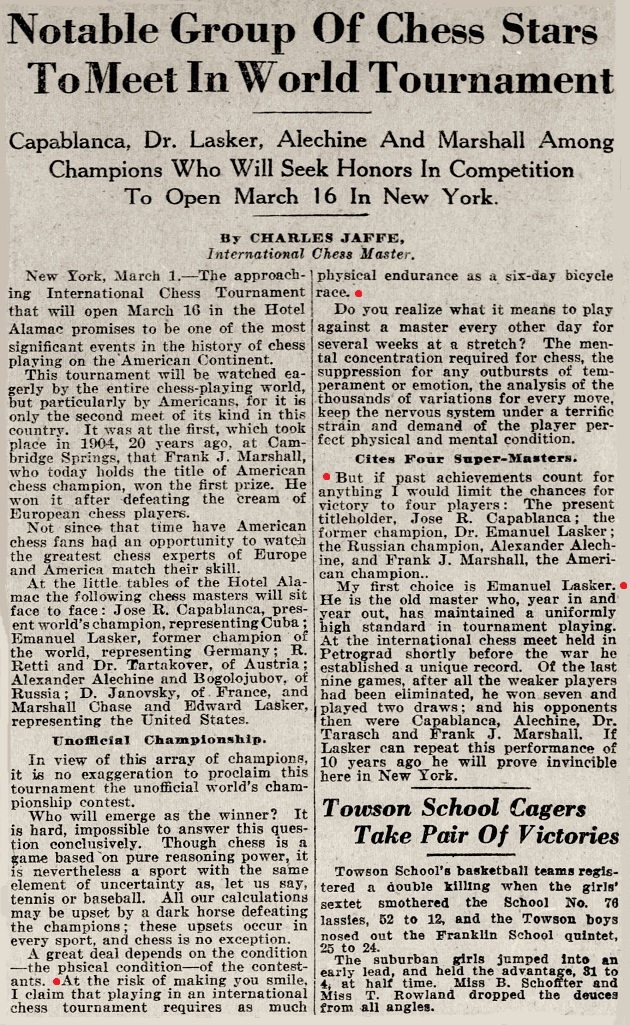
Baltimore Sun, 2 March 1924, page 4, part 1, section 2
The article is notable for the accuracy of Jaffe’s prediction about New York, 1924 and for his general remark about the arduousness of such events:
‘... playing in an international chess tournament requires as much physical endurance as a six-day bicycle race.’
(10926)
Shortly after the New York, 1924 tournament Bogoljubow began a match against Abraham Kupchik which has seldom been mentioned. There was a brief report on page 154 of the July-August 1924 American Chess Bulletin:
‘After six games of a match between E.D. Bogoljubow and A. Kupchik at the Manhattan and Rice-Progressive Chess Clubs, the score stands: Bogoljubow, 3; Kupchik, 1; drawn, 2. Twelve games in all are to be contested.’
The Bulletin did not revert to the subject and published no moves. However, Eduardo Bauzá Mercére (New York, NY, USA) has sent us all six games played. Twelve games were due to be contested, but the match was broken off when Bogoljubow led +3 –1 =2.
Efim Bogoljubow – Abraham Kupchik
First match-game, New York, 1924
Ruy López
1 e4 e5 2 Nf3 Nc6 3 Bb5 Nf6 4 d4 exd4 5 O-O d6 6 Nxd4 Bd7 7 Bxc6 bxc6 8 Qf3 c5 9 Nf5 Bxf5 10 Qxf5 g6 11 Qf3 Nd7 12 Qc3 Qf6 13 Qa5 Qd8 14 Nc3 c6 15 Qa4 Qc7 16 Bf4 Be7 17 Rad1 O-O 18 Rd2 Rfd8 19 Rfd1 Nf8 20 Qc4 Ne6 21 Bg3 Rab8 22 b3 Rb4 23 Qf1 Rd4 24 Rxd4 cxd4 25 Na4 Qb7 26 f4 c5 27 Re1 d5 28 f5 gxf5 29 exf5 Ng5 30 f6 Bf8 31 Re5 h6 32 Qf4 Qc8 33 Qh4 Re8 34 Rxd5 Qc6 35 Re5 Re6 36 Bf4 Rxe5 37 Bxe5 Kh7 38 Qf4 Qe4 39 Qxe4+ Nxe4 40 Kf1 Kg6 41 Ke2 Kf5 42 Bb8 a6 43 Kd3 Nxf6 44 Ba7 Nd7 45 Kc4 Ke4 46 Nxc5+ Bxc5 47 Bxc5 Ne5+ 48 Kb4 Nc6+ 49 Ka4 Kd5 50 Bf8 h5 51 g3 f5 52 h4 Ke4 53 b4 d3 54 cxd3+ Kxd3 55 b5 axb5+ 56 Kxb5 Nd4+ 57 Kb6 f4 58 gxf4 Nf5 59 a4 Nxh4 60 a5 Resigns.
Sources: Brooklyn Eagle, 30 May 1924 and New-Yorker Staats-Zeitung, 1 June 1924.
Abraham Kupchik – Efim Bogoljubow
Second match-game, New York, 1924
Ruy López
1 e4 e5 2 Nf3 Nc6 3 Bb5 a6 4 Ba4 Nf6 5 O-O Be7 6 Re1 b5 7 Bb3 d6 8 c3 O-O 9 d4 Bg4 10 Be3 exd4 11 cxd4 Na5 12 Bc2 Nc4 13 Bc1 c5 14 b3 Na5 15 e5 dxe5 16 dxe5 Qxd1 17 Rxd1 Nd7 18 h3 Nxe5 19 Nxe5 Bxd1 20 Bxd1 Bf6 21 f4 Nc6 22 Bb2 Rae8 23 Bf3 Nxe5 24 fxe5 Bxe5 25 Bxe5 Rxe5 26 Nd2 Rd8 27 Nf1 g6 28 Rc1 Rd4 29 Rc2 c4 30 bxc4 Rxc4 31 Rd2 b4 32 Ng3 Rc1+ 33 Kf2 Ra1 34 Bd1 h5 35 Bb3 h4 36 Ne2 Rf5+ 37 Ke3 Re1 38 Bd1 a5 39 Rd4 Ref1 40 Kd2 R5f2 41 Rxh4 Rxg2 42 Rd4 Rh2 43 Rd3 Rf5 44 Kc1 Re5 45 Kd2 Kg7 46 Rd7 a4 47 Rd4 b3 48 axb3 axb3 49 Rb4 Rd5+ 50 Kc1 Rd3 51 White resigns.
Sources: Brooklyn Eagle, 30 May 1924 and New-Yorker Staats-Zeitung, 1 June 1924.
Efim Bogoljubow – Abraham Kupchik
Third match-game, New York, 1924
Petroff Defence
1 e4 e5 2 Nf3 Nf6 3 d4 Nxe4 4 Bd3 d5 5 Nxe5 Be7 6 O-O O-O 7 c4 c6 8 Nc3 Nxc3 9 bxc3 Nd7 10 Nxd7 Bxd7 11 cxd5 cxd5 12 Qh5 f5 13 Qf3 Bc6 14 Bxf5 Bd6 15 Qh3 h6 16 Bc2 Qf6 17 Qd3 Rae8 18 Bd2 Re4 19 Rae1 Rfe8 20 Re3 R8e7 21 Rf3 Qe6 22 Rh3 Qd7 23 c4 Bf4 24 Bxf4 Rxf4 25 Qh7+ Kf8 26 Bg6 Re2 27 Qh8+ Ke7 28 Qxg7+ Kd8 29 Qxh6 Qg4 30 Bh5 Resigns.
Sources: Brooklyn Eagle, 30 May 1924 and New-Yorker Staats-Zeitung, 1 June 1924.
Abraham Kupchik – Efim Bogoljubow
Fourth match-game, New York, 1924
Queen’s Pawn, Bogoljubow Defence
1 d4 Nf6 2 Nf3 e6 3 c4 Bb4+ 4 Nbd2 O-O 5 e3 Nc6 6 a3 Bxd2+ 7 Bxd2 Ne4 8 Bd3 Nxd2 9 Qxd2 d6 10 Qc2 f5 11 O-O-O Qf6 12 d5 Nd8 13 e4 e5 14 exf5 Bxf5 15 Bxf5 Qxf5 16 Qxf5 Rxf5 17 Rhf1 b6 18 Nd2 Nb7 19 Kc2 a5 20 f3 a4 21 Ne4 Raf8 22 Rfe1 Rf4 23 Kc3 Rh4 24 h3 Ra8 25 Re2 Ra5 26 Kb4 Rf4 27 Nc3 Rd4 28 Ree1 Rc5 29 Rxd4 exd4 30 Nxa4 Ra5 31 Re8+ Kf7 32 Rc8 Kf6 33 Rxc7 Nc5 34 Nxc5 bxc5+ 35 Kb3 Ra8 36 Rd7 Ra6 37 Kc2 h5 38 h4 g6 39 Kd3 Rb6 40 b4 Ra6 41 Ke4 g5 42 hxg5+ Kxg5 43 Rc7 d3 44 Ke3 d2 45 Kxd2 cxb4 46 axb4 Kf4 47 Kd3 Kg3 48 Rg7+ Kh4 49 c5 dxc5 50 g3+ Resigns.
Sources: Brooklyn Eagle, 5 June 1924 and New-Yorker Staats-Zeitung, 1 June 1924.
Efim Bogoljubow – Abraham Kupchik
Fifth match-game, New York, 1924
Ruy López
1 e4 e5 2 Nf3 Nc6 3 Bb5 a6 4 Ba4 Nf6 5 d4 exd4 6 O-O Be7 7 e5 Ne4 8 Re1 Nc5 9 Bxc6 dxc6 10 Nxd4 Ne6 11 Nf5 Qxd1 12 Rxd1 Bf8 13 Nc3 Bd7 14 Be3 O-O-O 15 Ne4 h6 16 Nfg3 b6 17 f4 Re8 18 Rd2 c5 19 Rad1 Bc6 20 c3 Be7 21 Nd6+ cxd6 22 exd6 Bf6 23 d7+ Bxd7 24 Rxd7 Nd4 25 Rxf7 Rxe3 26 cxd4 Bxd4 27 Kf1 Re6 28 b4 Rd8 29 bxc5 bxc5 30 Nf5 Rf6 31 Rxf6 Bxf6 32 Rxd8+ Kxd8 33 Ke2 Kd7 34 Kd3 Ke6 35 g4 h5 36 h3 hxg4 37 hxg4 g5 38 fxg5 Bxg5 39 Kc4 Ke5 40 a4 Kf4 41 Nd6 Drawn.
Sources: Brooklyn Eagle, 5 June 1924 and New-Yorker Staats-Zeitung, 8 June 1924.
Abraham Kupchik – Efim Bogoljubow
Sixth match-game, New York, 1924
Grünfeld Defence
1 d4 Nf6 2 Nf3 g6 3 c4 Bg7 4 Nc3 O-O 5 h3 d5 6 cxd5 Nxd5 7 e4 Nxc3 8 bxc3 c5 9 Be2 Nc6 10 Be3 cxd4 11 Nxd4 Qa5 12 O-O Qxc3 13 Rc1 Qa5 14 Nxc6 bxc6 15 a4 Rd8 16 Qb3 Ba6 17 Bxa6 Qxa6 18 Qc4 Qxc4 19 Rxc4 a5 20 Rfc1 Rab8 21 Rxc6 Bd4 22 Bf4 Rb4 23 R1c4 Rxc4 24 Rxc4 Bb6 25 Kf1 Rd1+ 26 Ke2 Rg1 27 g3 f6 28 Rc6 Bd4 29 Rc1 Rxc1 30 Bxc1 Kf7 31 f3 Ke6 32 Kd3 Bf2 33 Bd2 Bxg3 34 Bxa5 Kd7 35 Kc4 f5 36 exf5 gxf5 37 Bb4 e6 38 a5 Kc6 39 Bc5 h5 40 a6 h4 41 Be3 Bc7 42 a7 Kb7 43 Kb5 Bg3 44 Bc5 Bc7 45 Bf2 Bg3 46 Be3 Bd6 47 a8(Q)+ Kxa8 48 Kc6 Bg3 49 Kd7 e5 50 Ke6 f4 51 Bc5 e4 52 fxe4 f3 53 e5 Kb7 Drawn.
Sources: Brooklyn Eagle, 5 June 1924 and New-Yorker Staats-Zeitung, 8 June 1924.
(2893)
Regarding the chess governing body, which was founded in 1924, see Chess: The History of FIDE.
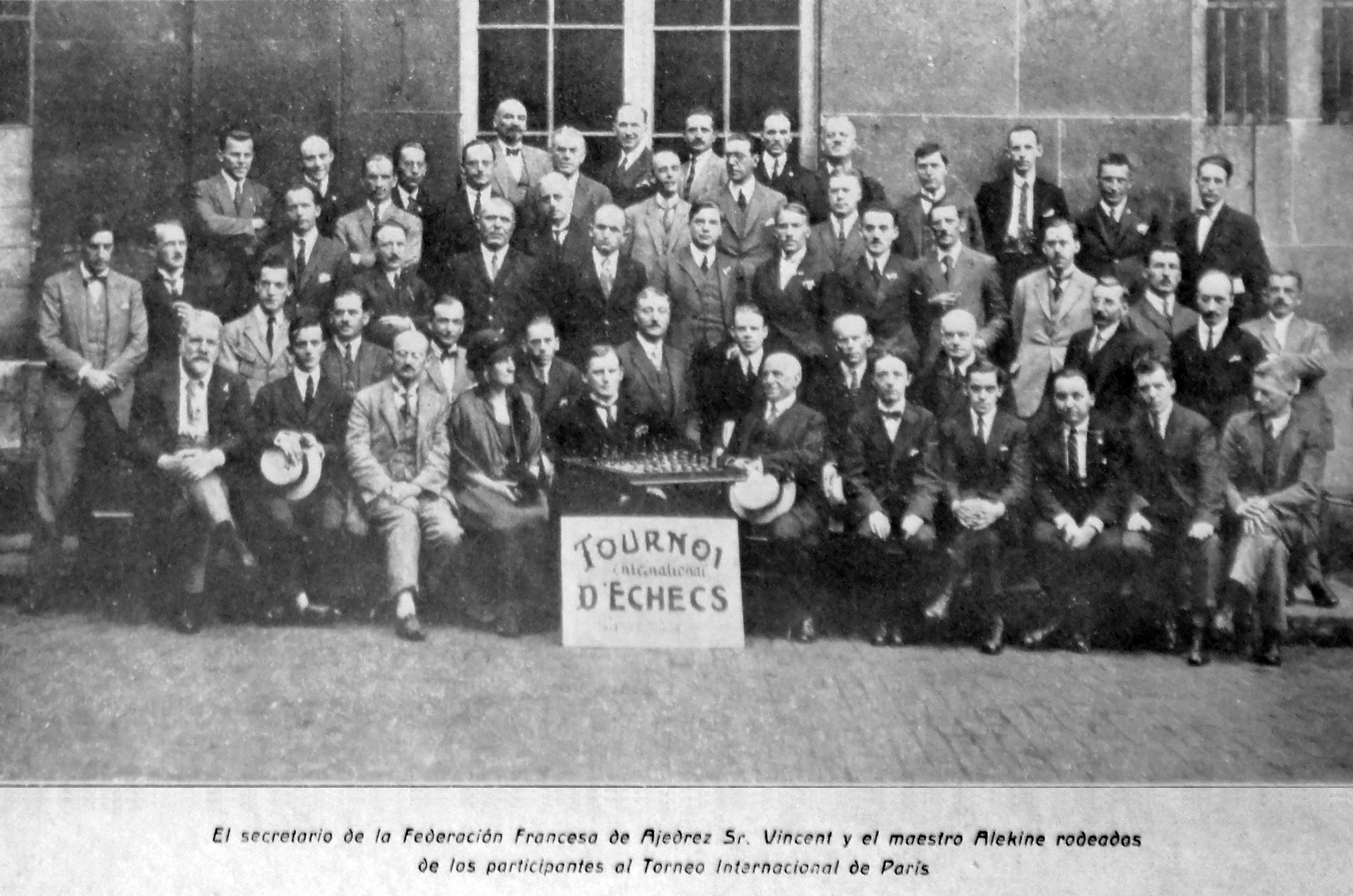
The Meran Variation of the Queen’s Gambit includes a group photograph of Meran, 1924 and also of Győr, 1924 (in a discussion of players named Steiner).
The five photographs below are reproduced from the American Chess Bulletin of 1924:
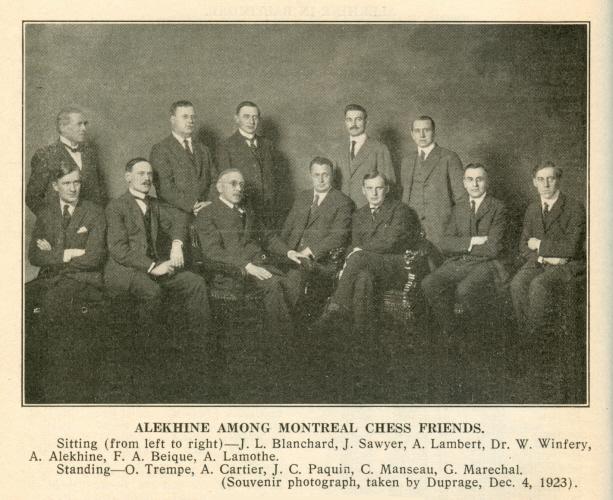
January 1924 Bulletin, page 6
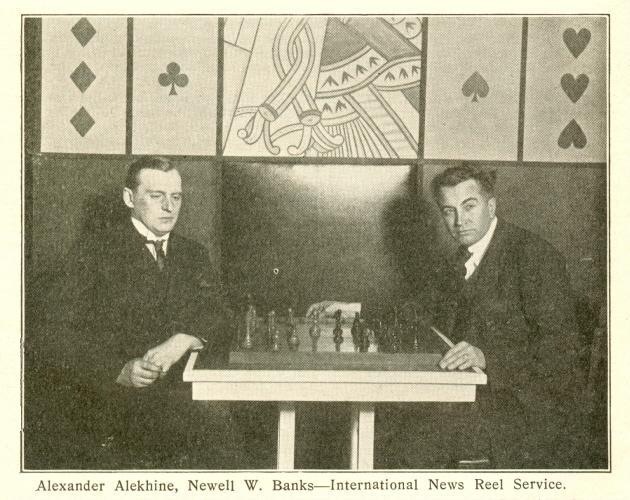
February 1924, page 28
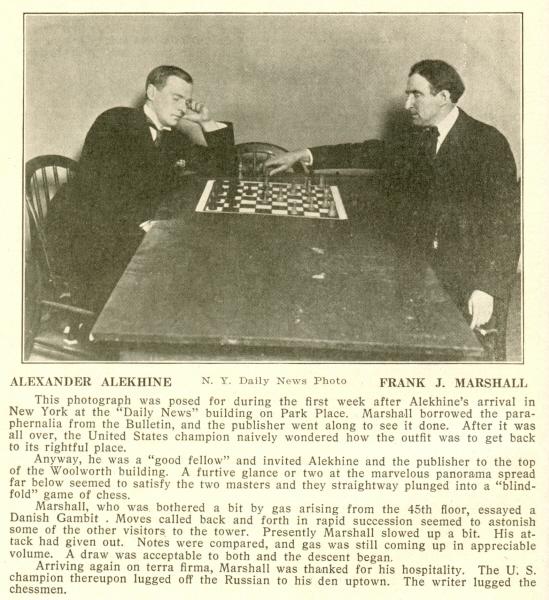
February 1924, page 30
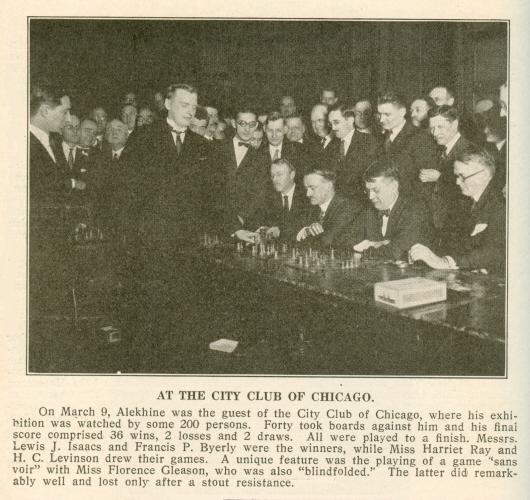
March 1924, page 56
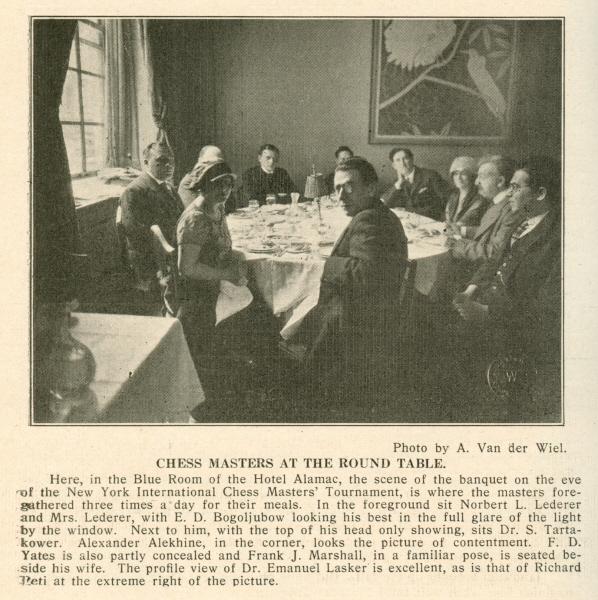
May-June 1924, page 106
(4985)
See too:
An Alekhine Blindfold Game. The future world champion’s famous victory over Frieman.
The Gibaud v Lazard Gamelet. Discussion of a game often claimed to have occurred in 1924.
Joseph Henry Blackburne. Our feature article on the chess world’s greatest loss in 1924.
To the Chess Notes main page.
To the Archives for other feature articles.
Copyright: Edward Winter. All rights reserved.